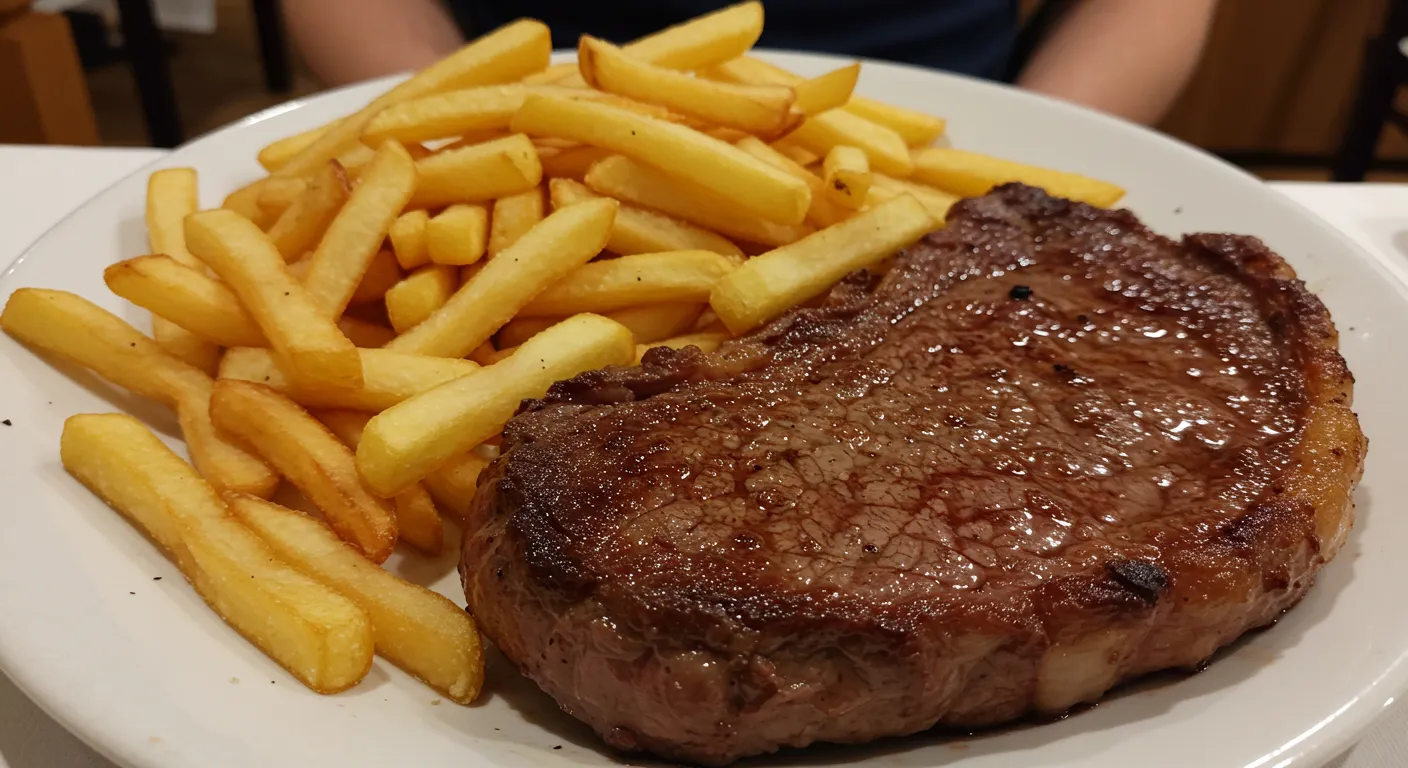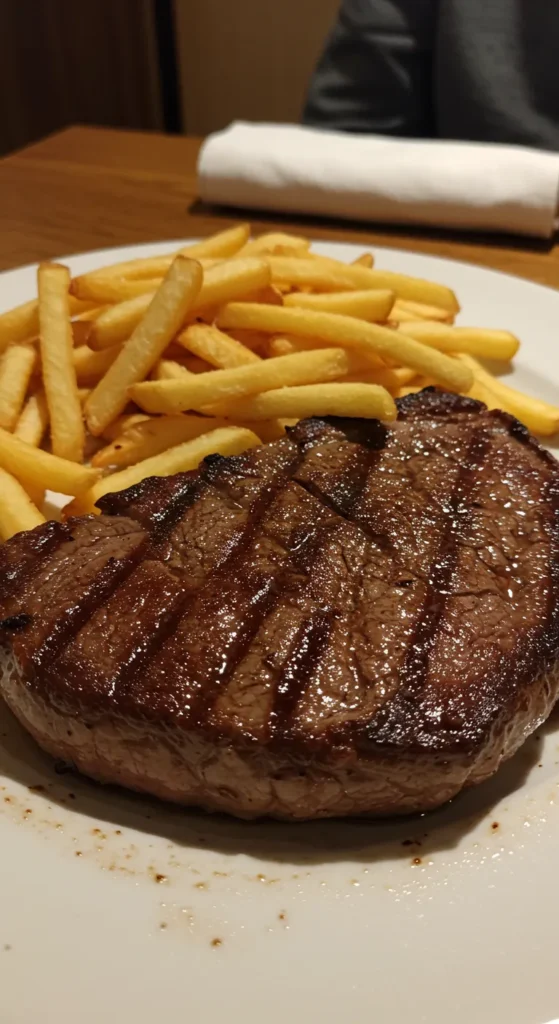
Table of Contents
Imagine a busy Parisian bistro on a cool autumn night. The sound of a steak sizzling meets the crunch of frites. This is steak frites, a dish that feels like a hug from French and Belgian cooking.
I love food and have seen many kitchens and brasseries. Steak frites shows us the beauty of simple yet amazing bistro food. It’s a sign of how great ingredients and skill can create magic.
Steak frites is more than just food; it’s a work of art. From the beef to the fries, every part has a story. It’s about tradition and being precise.
Key Takeaways
- Steak frites is a classic dish from Belgian and French cuisine
- The perfect dish needs the right meat and cooking skills
- Bistro food is all about keeping it simple and using the best ingredients
- The right seasoning and sauce make the meal even better
- Learning to make steak frites is about getting the temperature and timing right
Understanding Steak Frites: Origins and History
The story of steak frites is a tasty journey. It connects two food-loving cultures. This dish is more than a meal. It shows the deep food history of Belgium and France.
French vs Belgian Claims to the Dish
Steak frites starts a fun food fight between Belgium and France. Belgium says they made french fries in the 1600s. But France also says they created the dish.
- Belgium suggests inventing french fries as early as the 17th century
- Belgian fries must be at least 10 millimeters thick
- Steak frites appears on nearly every French restaurant menu worldwide
Evolution in Modern Cuisine
Steak frites has grown from a simple dish to a world-famous meal. Chefs now try new beef cuts and cooking ways.
| Beef Cut | Typical Weight | Cooking Time |
|---|---|---|
| Sirloin | 230-250 grams | 3-5 minutes |
| Bavette | 230-250 grams | 4-6 minutes |
Cultural Significance
Steak frites is more than food. It shows the love for cooking in Belgium and France. It’s about making simple things into something amazing.
“In every slice of steak and crisp of frite, we taste the history and soul of two remarkable culinary traditions.”
Selecting the Perfect Cut of Beef
Choosing the right beef cut is key for sizzling steaks. French bistros focus on flavor, not just tenderness. I’ll show you the best beef tenderloin and other great steak choices.
- Ribeye: The king of steaks, known for exceptional marbling and rich, buttery flavor
- New York Strip: Balanced marbling with slightly leaner composition
- Tenderloin: Most tender cut with a smooth, melt-in-your-mouth texture
- Sirloin: Versatile cut from the upper rear back
Knowing cooking temperatures is key for perfect results:
| Doneness | Temperature Range | Characteristics |
|---|---|---|
| Medium-Rare | 130-140°F | Ideal for most tender cuts |
| Medium | 140-150°F | Slightly more cooked, balanced flavor |
“The right cut transforms an ordinary meal into an extraordinary dining experience.” – Chef Randy Feltis
Pro tip for home cooks: Try reverse-searing your ribeye. Cook it low, then sear it high. This makes the steaks tender and sizzling, impressing everyone.
Essential Ingredients for Restaurant-Quality Steak Frites
To make steak frites like a pro, pick the right ingredients. I’ll show you how to choose the best parts for a dish that’s truly special.
Meat Selection Guidelines
Ribeye is the top pick for steak frites. It’s full of marbling, which makes it juicy and flavorful. Look for these things:
- Consistent marbling throughout the cut
- Deep red color without brown spots
- Thickness around 1 inch for optimal cooking
Potato Varieties for Frites
Choosing the right potato is key for great french fries. Russet potatoes are the best because they’re dry and get crispy.
| Potato Type | Characteristics | Ideal for Fries |
|---|---|---|
| Russet | Low moisture, high starch | Excellent crispy texture |
| Yukon Gold | Medium starch | Good alternative |
Seasoning and Sauce Components
To make your steak frites amazing, use top-notch seasonings and sauces. Here’s what I recommend:
- Flaky sea salt for finishing
- Freshly ground black pepper
- Classic béarnaise or green peppercorn sauce
Pro tip: Prepare your béarnaise sauce with care, whisking egg yolks over low heat to prevent scrambling.
By choosing the best ingredients and following these tips, you’ll make steak frites that will wow everyone.
The Art of Preparing the Perfect Steak
Creating sizzling steaks is all about precision and technique. I’ll show you how to make an ordinary cut of beef into a masterpiece.
The journey to a great steak starts with careful prep. Here are the key steps:
- Select a high-quality cut with good marbling
- Bring steak to room temperature (about 30-45 minutes)
- Pat the meat completely dry with paper towels
- Season generously with coarse sea salt and black pepper
“The secret to sizzling steaks is managing heat and timing with surgical precision.” – Professional Chef’s Wisdom
Use a heavy cast-iron skillet for the best heat. The cooking process needs your full attention:
| Steak Thickness | Cooking Time per Side | Recommended Temperature |
|---|---|---|
| 1 inch | 2-3 minutes | 130-135°F (Medium Rare) |
| 1.5 inches | 3-4 minutes | 130-135°F (Medium Rare) |
After cooking, let your steak rest for at least 10 minutes. This step makes sure each bite is tender and full of flavor.
Pro tip: Slice the steak against the grain. This makes it tender and looks professional, impressing all food lovers.
Mastering the Cold-Start Frying Technique
Making crispy frites at home can be tricky. But, the cold-start frying technique makes it easier. I’ll show you how to turn regular potatoes into crispy frites with little effort.
- Reduces oil use by up to 50%
- Less mess and splatter in the kitchen
- Even potato texture
- Better control over temperature
Benefits of Cold-Start Method
Starting with cold oil and potatoes helps cook evenly. The method lets potatoes slowly release moisture. This makes the outside crispy and the inside soft. Research shows that controlling temperature is key for texture and taste.
Step-by-Step Frying Process
- Choose starchy potatoes like Russet
- Cut potatoes into the same size strips
- Soak strips in cold water for 30-60 minutes
- Drain and dry them well
- Put potatoes in cold oil
- Heat oil slowly to about 300°F
- Cook for 10-15 minutes
Troubleshooting Common Issues
Even skilled cooks face problems with crispy frites. Here are common issues:
- Soggy frites: Make sure potatoes are dry
- Uneven cooking: Use the same potato thickness
- Oil temperature changes: Use a good thermometer
“Perfection in cooking is about understanding techniques, not just following recipes.” – Professional Chef Insight
Classic Sauce Pairings for Steak Frites
In the world of bistro cuisine, the right sauce can make a simple steak frites into a masterpiece. My journey through Parisian classics has shown me amazing sauce pairings. These pairings take this beloved dish to new heights.
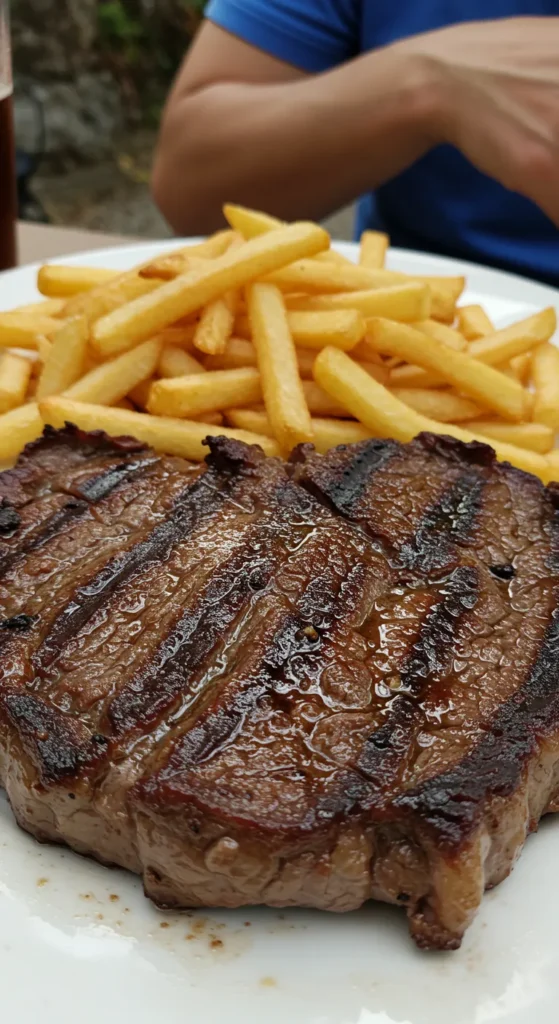
- Béarnaise Sauce: A creamy, herb-infused classic that brings sophistication to your plate
- Green Peppercorn Sauce: Bold and punchy, with a remarkable depth of flavor
- Beurre Maître d’Hôtel: A simple yet elegant butter sauce with fresh herbs
Chef Andrew Carmellini’s sauce-making inspires me. He infuses butter with béarnaise ingredients. This shows the creativity in traditional bistro cuisine. The key is balancing flavors while respecting the original Parisian classics.
“The perfect sauce can transform a good steak into an unforgettable experience.” – Professional Chef’s Wisdom
When making these sauces, focus on fresh ingredients and precise technique. The right sauce should complement, not overpower, the beautiful char of a perfectly cooked steak.
- Use fresh tarragon for authentic béarnaise
- Crush green peppercorns just before adding to the sauce
- Ensure butter is at the perfect temperature for emulsification
My culinary exploration has taught me that mastering these sauce pairings is an art form in bistro cuisine. It’s a delicious bridge between tradition and innovation.
Professional Tips for Timing and Temperature
Mastering gourmet dining starts with cooking steak frites right. Timing and temperature control are key. Here are some pro tips to boost your cooking skills.
Cooking Schedule Essentials
Perfect steak frites need a good plan. Here’s a cooking schedule:
- Prep steak: Remove from fridge 30 minutes before cooking
- Preheat skillet: 5 minutes before cooking
- Cook steak: 2-3 minutes per side
- Rest steak: 5-10 minutes
- Prepare frites: 15-20 minutes
Temperature Control Methods
Being precise is key in gourmet cooking. Use a meat thermometer for the best doneness:
| Doneness | Internal Temperature | Cooking Time |
|---|---|---|
| Rare | 125-130°F | 8 minutes |
| Medium Rare | 130-135°F | 9 minutes |
| Medium | 135-140°F | 10 minutes |
Resting and Serving Guidelines
Resting is key for juicy steak frites. Always let your steak rest for at least 5 minutes after cooking. This makes it tender and flavorful.
“Patience is the key to transforming a good meal into an extraordinary dining experience.” – Professional Chef
Pro tip: Cover the steak with foil while it rests. This keeps it warm and perfect. Your steak frites are now ready to wow!
Plating and Presentation Techniques
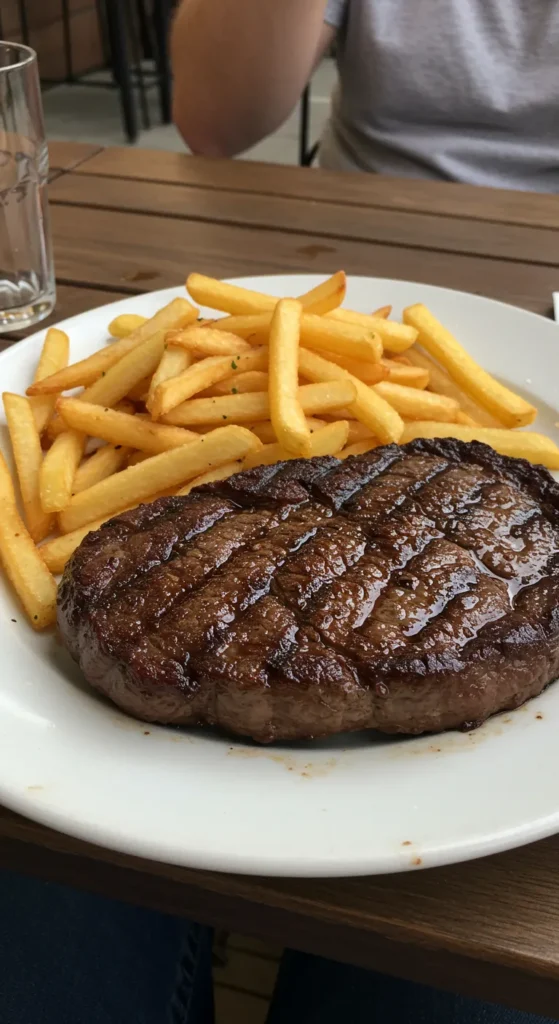
Creating a stunning bistro cuisine experience is more than just cooking. The art of plating turns your steak frites into a feast for the eyes. It makes your meal a true culinary delight.
Choosing the right plate is key. White plates are the favorite of over 70% of chefs. They make the colors of your dish pop. The right plate can make your steak look 30% more appealing.
- Choose a 12-inch white plate for maximum visual impact
- Create height by stacking frites strategically
- Position the steak at a slight angle for dynamic presentation
Professional chefs see presentation as an art. Here are some tips to make your steak frites look amazing:
- Slice the steak against the grain after a 5-10 minute rest
- Use bright vegetables like snap peas or carrots for color contrast
- Drizzle sauce elegantly around the plate, not over the entire dish
“Eating is a sensory experience. The first bite is always with the eyes.” – Unknown Chef
Garnishing can make your dish look 15-20% better. Fresh herbs, a small pat of herb butter, or a green leaf can make your plate look like a restaurant’s.
Pro tip: Always edit your plate before serving. Less is more when it comes to elegant plating.
Wine Pairing and Serving Suggestions
Make your steak frites special by choosing the right wine. I love finding the perfect wine for this dish. It makes the meal feel fancy.
Red Wine Recommendations
Think about the steak’s type and taste. For fatty ribeye, pick strong red wines. The Les Baux-de-Provence area has great choices:
- Cabernet Sauvignon from Mas de Gourgonnier estate
- Grenache-based blends
- Syrah with deep, complex flavors
Alternative Beverage Pairings
Not everyone likes wine. Here are other fancy drinks that go well with steak frites:
- Craft beer with caramel notes
- Artisanal sparkling water
- Non-alcoholic herbal aperitifs
Service Temperature Guidelines
Temperature is key for flavor. Serve red wines slightly below room temperature. This is about 60-65°F for the best taste.
“The right wine transforms a meal from good to unforgettable.” – Culinary Wisdom
| Steak Cut | Recommended Wine | Flavor Profile |
|---|---|---|
| Ribeye | Syrah | Bold, Tannic |
| Sirloin | Grenache Blend | Light, Fruity |
| Filet Mignon | Merlot | Smooth, Elegant |
Storage and Reheating Guidelines
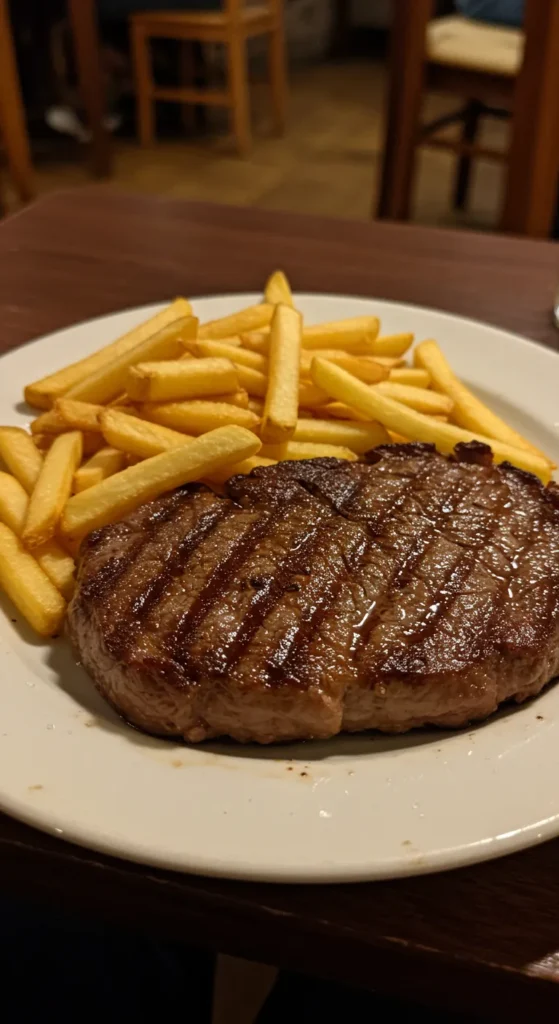
Keeping your steak frites tasty is key. You can enjoy it again with the right storage and reheating. This way, you get to relish the dish’s flavors even after it’s made.
Storage Recommendations
Put your steak frites in an airtight container in the fridge. It stays good for 3 days. Keep the steak and fries apart to keep the fries crispy.
Reheating Techniques
- Steak Reheating Method:
- Take the steak out of the fridge 30 minutes before you heat it up
- Heat your oven to 250°F and cook for 25-30 minutes
- Make sure it’s between 100-110°F inside
- Then, sear it for 60 seconds on each side in a hot pan
- Fries Crisping Technique:
- Heat your oven to 425°F
- Put the fries on a baking sheet
- Heat them for 5-7 minutes until they’re crispy
Storage Duration Guide
| Meat Type | Refrigerator Storage | Freezer Storage |
|---|---|---|
| Fresh Beef Steak | 3-5 days | 6-12 months |
| Cooked Meat Dishes | 3-4 days | 2-3 months |
Pro tip: Cook your steak a bit less than usual. This helps it reheat better the next day.
“Proper storage turns leftover steak frites into a treat.” – Culinary Expert
By following these tips, you can make your steak frites meals special again. Good storage and reheating are the secrets to enjoying it more than once.
Conclusion
We’ve looked into the world of steak frites, a favorite dish in the US. It’s loved in places like Lafayette and Balthazar in SoHo. This dish shows how simple food can be truly great.
Making steak frites at home might seem hard. But, it’s worth it for a meal that feels like a French bistro. You can choose from different steak sizes and prices, making it fun for everyone.
Even as beef gets more expensive, steak frites is a good deal. Places like Corner Bar and Libertine are making it new again. Try it out and make it your own.
Learning to make steak frites is more than just a recipe. It’s about getting the flavors and textures right. So, get ready to make a dish that will wow your friends and family.
FAQ
What’s the difference between French and Belgian steak frites?
French and Belgian steak frites have small differences. French versions are more refined. Belgian ones are a bit rustic.
What’s the best cut of beef for steak frites?
Beef tenderloin or sirloin are great choices. They are tender and flavorful. Flank steak is also good if you want to save money.
How do I achieve perfectly crispy french fries?
Use cold-start frying for crispy frites. Start with cold potatoes in cold oil. Double-fry them for extra crispiness. Salt the fries right after frying for the best taste.
What sauces pair best with steak frites?
Béarnaise and green peppercorn sauces are top choices. Béarnaise is creamy and herbal. Green peppercorn sauce is spicy. Compound butter or red wine reduction are also good.
What wine should I serve with steak frites?
Cabernet Sauvignon, Malbec, and Syrah pair well with steak frites. Pinot Noir is good for lighter tastes. Craft beer or sparkling water with lemon are nice alternatives.
How do I cook the steak to the perfect doneness?
Use a meat thermometer for the right temperature. Let the steak rest for 5-10 minutes after cooking. This makes it tender and flavorful. A cast-iron skillet is best for searing.
Can I prepare steak frites in advance?
You can prepare parts of it ahead. Cut and soak potatoes early. Season the steak the day before. Reheat fries in a hot oven. Warm the steak gently to avoid overcooking. Don’t microwave, as it ruins the texture and taste.

